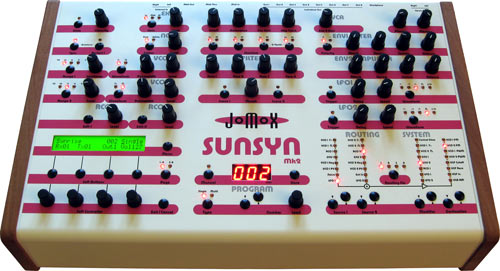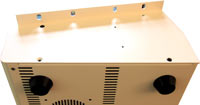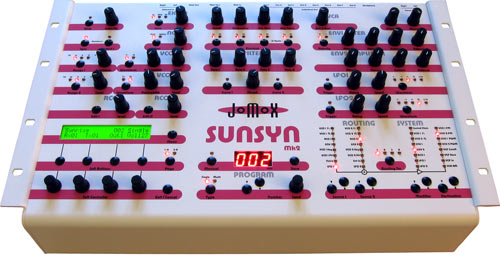|
|
|
|
|
| SunSyn Mk2 - Discontinued |
|
Sorry - not available any more!
Sorry, there is no SunSyn Mk2 any more!!!
And please don't send emails to us asking if the SunSyn will be ever produced again - useless;-)
Best Regards, your Jomox Team
The word "8-fold storable modular system" would describe this unit in
a much better fashion, and exactly this is the SunSyn.
Each voice is a monophonic complex synthesizer of its own.
The special idea of
the SunSyn is the following list of features:
- 2 analog VCOs
- 2 digital wavetables/samples - uploadable
- Analog x-pole filters with morphing
- Analog envelopes
- Digital LFOs
- Analog routing matrix, which takes 50% of the hardware space on each voice card.
Means, the best of all worlds unified in one hardware.
Analog
is most powerful if it is STOREABLE and you can control it by midi with
a computer. Otherwise you start again from scratch each time you have a wonderful sounding preset...
* Oscillator Section
Every SunSyn voice has two true analog oscillators, built up
in discrete circuit technology and featuring the classic waveforms saw,
square and pulse with pulse width modulation.
Besides that,
every voice has two so called RCOs (Ramp Controlled Oscillator).
It's
the first time digital waveforms can be mixed with true analog VCOs.
Therefore
digital waveforms become alive like never before and open up new
dimensions of sound estethics. That makes a total of 4 oscillators per
voice.
The RCOs are organized in 7 wave sets with 252 waveforms each that are stored in the internal flash memory. These can be uploaded with a free SunSyn Wave Editor tool by midi dump.
The RCOs are also capable to play back short samples and to digitally FM modulate themselves or serve as a modulation source in the analog routing matrix.
* Filter Section
The filter section contains a fully configurable 4 pole true
analog filter. On each pole, high/lowpass characteristics and
coefficients (i.e. the basic cutoff frequency for each pole) can be
adjusted individually. So you have the possibility to crossfade
continously from a typical Moog 4pole to an 18db - 303 lowpass to an
Oberheim-like 2pole filter.
Additionally, using the HP/LP
switching for each pole, it is possible to create the most spacy
bandpass- and highpass-filter sounds.
Furthermore, you can store all filter-parameters in 2 scenes and MORPH (in the analog domain!) between them.
* Envelopes
According to the machines conception, both envelopes are
discreet analog circuits and super fast. One can be inverted. Typical
envelope modulation paths are hard wired and have their own knob on the
front panel.
* LFO's
There are two LFOs
per voice. Each one can be delayd or applied to events. Waveforms are
triangle, saw up/down, square and random. The rate is adjustible between
approx. 1kHz and 0,02Hz to create super slow sweeps.
* Modulation
One of the most exiting innovations of the SunSyn is the
routing system. It turns the SunSyn into an 8-voice modular synth with
programmable routing system. And it is absolutely easy to use.
In addition to the fixed routings (e.g. Env1->VCA) you have 4
flexible and programmable routing paths per voice, called Routing
Element.
Source 1
(1 of 8) | + Source 2
(1 of 8)
| * Modifier
(1 of 8)
| > Destination
(1 of 8)
| VCO1 S
VCO1 R
RCO1
ENV 1
VCO1KV
VCO1PV
NOISE
LFO1 | VCO2 S
VCO2 R
RCO2
ENV 2
VCO2KV
VCO2PV
EXT IN
LFO2 | Controller
VCO1 S
VCO2 R
ENV 1
ENV2
RCO1
LFO1
LFO2 | VCO1 FM
VCO2 FM
VCO1 PW
VCO2 PW
VCF CUT
VCF RES
VCF IN
VCA AMT
|
You can picture routing elements as a
modular system's cable, with two inputs (sources) and one output
(destination). They are connected by an electronically controlled knob
(modifier) to control the intensity.
The intensity itself
can be modulated by any Midi-Controller (e.g. controller, velocity,
aftertouch) or by an analog audio-signal from the SunSyn. So you create
'modulated modulations'.
Besides that, the signals of each
voice can modulate among each other. Up to now, this was only possible
with 'real' (and huge) modular systems.
Everything works
of course in the analog domain. Therefore no operation is limited by
fixed point calculation errors (as in DSPs), but instead offers full
dynamic-range for chaotic effects which apear on many modulations.
Every modulation path is easy edited and understandable by one single view on the front panel.
An example:
Both VCOs are cross-modulated. This needs 2 Routing Elements,
one for each voice. The intensity of the modulation can be controlled by
e.g. key velocity. But this is just for starters.
At the
same time, an external audio signal is mixed with noise and cutted into
pieces by LFO1 and is mixed into the filter input.
Now
there still remains one Routing Element to e.g. ringmodulate RCO1and
RCO2, and let the result modulate the VCA amount (if RCO2 is the source
and RCO1 the modifier, both signals get multiplied; the result is a ring
modulation).
The final sound result should be spaced out in every sense of the word.
* Control Panel
There is a knob or lighted button on the control panel for every important function. All in all, there are 40 of them.

The SunSyn has a 48 character-LCD with 4 soft-controllers and 4
soft-buttons to handle several edit-menues in an easy way.
A three character LED shows programm number and the actual parameter value.
* Sound storage
The SunSyns internal memory can handle 256 single sounds, 128 multis and 7 wavesets.
* Midi
All knob movements and keypad events are sent and received as Midi controller data.
We will deliver editor templates for the best known software sequencer systems.
* In / Outputs
The SunSyn has a stereo-out. Stereo-panning can be modulated
by an own LFO. There are also 8 freely routable individual outs. All out
sockets are electronically balanced tip/ring on 1/4 inch jacks. The
headphone-out has its own volume knob.
Besides that there
is a stereo input to send external audio signals or control voltages
into the SunSyns routing system.
* Power supply
The SunSyn has an internal power supply. It is a clean and
computer controlled audio power supply, specially designed to avoid any
unwanted effects to the audio circuits. The line voltage is switchable
230/110V and the power cable is removable.
* Casing
The SunSyn Mk2 is housed in a solid metal case with wooden side
panels.


| 
|
It can be used as desktop unit or can be turned into a 19" rack
unit by removing the end woods and turning around the metal sides underneath the woods.

The SunSyn Mk2 is available in white or black color with purple stripes. At your choice are standard black plastic knobs as well as fine metal knobs in gold, ruthenium or black with a shining surface.
© 2000-2010 JoMoX GmbH
|
|
|
|
|
| Specifications |
|
Number of Voices 8 times full multitimbral
VCO's 2 per voice; waveforms: saw, pulsewidth
RCO's 2 per voice, playing back of samples and FM RCO1->2 possible
Filter
4 pole fully configurable, individual cutoff and HP/LP switching for
each pole; analog morphing between two filter setups is possible. True
two pole switching is possible
Envelopes 2 ADSR per voice, real analog RC-envelope (discrete circuitry)
LFO's 2 per voice individually, waveforms triangle, sawtooth up/down, rectangle and random
Routing Elements 4 per voice. Analog modulation matrix with 4096 possible combinations per Routing Element
Presets 256 Single / 127 Multi
Display LCD 2x24 characters, LED 3x7 segment for parameter display
Soft controller 4 incremental encoders
Midi Midi In, Midi Out, Midi Thru
User Interface 40 knobs, 42 buttons, 85 LED's
Outputs 8 individual outputs, 1 stereo mix out, 1 HP out
Output Level about +4dBu at all outputs
Inputs 2 external inputs, can be used for audio and CV
Supply 220/110 V line voltage selectable
Dimensions 19" 6 RU
470 x 290 x 170(back) x 90(front) mm
Weight about 8 kg, 17 lbs
|
|
|
|
|
|
|
| Audio Demos |
|
|
|
|
|
|
|
|
| Size: 667 KB |
(stereo, 192kBit/s) |
by Matthias Fuchs |
|
|
|
|
|
|
|
|
|
|
| Updates |
|
|
|
|
|
|
|
|
| Size: 130 KB |
|
13.12.2011 21:58 |
|
|
|
|
|
|
|
|
|
|
| Size: 51 KB |
|
06.07.2012 13:36 |
|
|
|
|
|
|
|
|
|
|
| Size: 41 KB |
|
06.07.2012 13:37 |
|
|
|
|
|
|
|
|
|
|
| Size: 126 KB |
|
06.07.2012 13:36 |
|
|
|
|
|
|
|
|
|
|
| Size: 2120 KB |
|
06.07.2012 13:37 |
|
|
|
|
|
|
|
|
|
|
| Tools |
|
|
|
|
|
|
|
|
| Size: 242 KB |
|
06.07.2012 13:35 |
|
|
|
|
|
|
|
|
|
|
| Size: 264 KB |
|
09.10.2020 17:17 |
|
|
|
|
|
|
|
|
|
|
| Size: 171 KB |
|
29.09.2023 00:00 |
|
|
|
|
|
|
|
|
|
|
| Size: 242 KB |
|
29.09.2023 00:00 |
|
|
|
|
|
|
|
|
|
|
| Size: 40 KB |
|
09.06.2022 14:02 |
|
|
|
|
|
|
|
|
|
|
| Size: 2051 KB |
|
29.09.2023 00:06 |
|
|
|
|
|
|
|
|
|
|
| Size: 1123 KB |
|
29.09.2023 00:05 |
|
|
|
|
|
|
|
|
|
|
| Manuals |
|
|
|
|
|
|
|
|
| Size: 2003 KB |
|
12.10.2010 20:45 |
|
|
|
|
|
|
|
|
|
|
| Size: 2254 KB |
|
12.10.2010 20:45 |
|
|
|
|
|
|
|
|
|
|
| Size: 32 KB |
|
06.07.2012 13:43 |
|
|
|
|
|
|
|
|
|
|
|
| < Back |
|
|
|
|
|